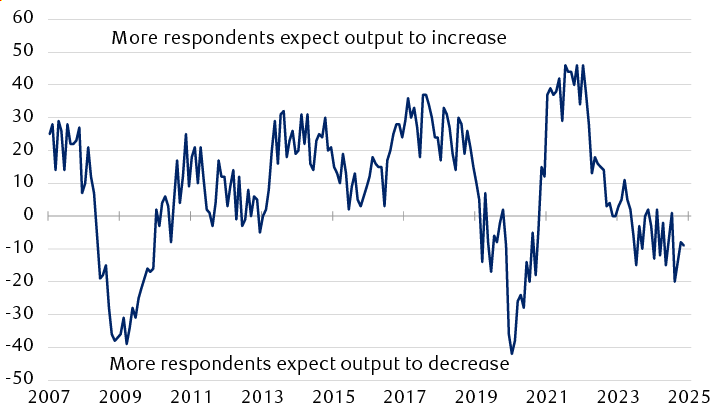UK equities
Following a cautious start, the Labour government has achieved two milestones: a rapprochement with Europe along with possible further steps in the future and a ‘trade agreement’ with the U.S. Though the 10 percent baseline U.S. tariff remains, there is some tariff relief for UK cars, steel and aluminium, resulting in an 11 percent average U.S. effective tariff rate on UK imports.
While these are important achievements, we believe the impact on the UK economy is likely to be muted. The re-engagement with the EU merely rolls back some of the obstacles introduced by Brexit, while the new average effective tariff on UK exports is not substantially different from what would have applied had the reciprocal tariffs remained in place.
The UK economy started the year on a reasonable footing, but in our view, large increases in taxes and energy costs will likely hinder economic growth. Surveys by the Confederation of British Industry and market research company GfK point to continued deterioration of business and consumer confidence. RBC Capital Markets expects GDP growth of only 1.0 percent in 2025 and 0.9 percent in 2026.
The government is attempting to tackle the sluggish economy with plans for homebuilding, defence and infrastructure spending. The Prime Minister announced an increase in defence spending to 2.5 percent of GDP by 2027 from the current 2.3 percent, with further increases likely, while the Chancellor set aside £113 billion for infrastructure projects over the current parliament. Taxes, as well as borrowing, will probably have to rise even further.
For large-cap equity investors, attractive valuation levels matter more than the domestic backdrop. The latter tends to have a more pronounced impact on small-cap equities.
The FTSE All-Share Index is trading well below its long-term median price-to-earnings ratio relative to global developed markets, even accounting for sector differences.
Though we currently suggest a modest Underweight in UK equities, quality UK large-cap stocks trading at a valuation discount to foreign competitors are an attractive opportunity for global investors, in our view. We also favour attractively valued Financials, given their high level of shareholder returns via both dividends and share buybacks.
UK business sentiment has deteriorated
CBI Industrial Order Expectations

The line chart shows the results of the Confederation of British Industry’s monthly Industrial Order Expectations survey from May 2007 through March 2025. Respondents are asked whether they expect output to increase or decrease over the next three months. More respondents expected decreases during the great financial crisis (2008-2010), during the COVID-19 pandemic (2020-2021), and since the beginning of 2024.
Source - Confederation of British Industry
UK fixed income
The Bank of England (BoE) is on a “careful and gradual” path. While our base case is 75 basis points (bps) of easing through to year end, upside inflation risks remain especially in services, which could apply the brakes on cuts. Wage inflation is still meaningfully above the 3.0 percent to 3.5 percent level consistent with a 2.0 percent inflation level, but more importantly recent data shows signs of cooling. Furthermore, we think business hiring intentions will continue weakening, thus limiting wage growth and ultimately headline inflation in H2 2025.
The UK’s fiscal situation is also under pressure, with Q1 government borrowing data reaching the fourth highest on record. The Treasury’s spending needs are high, particularly in healthcare, education, and defence. While higher borrowing costs and lower productivity growth are exacerbating these fiscal pressures, we estimate a fiscal hole of £13–£23 billion depending on spending timelines. The Chancellor has three options to address this: (1) adjust the self-imposed fiscal rules, (2) cut departmental expenditures, (3) or raise taxes.
The Treasury’s decision to skew issuance further towards shorter-dated debt is likely due to declining demand from insurance and pension funds, and to higher longer-dated bond yields. While this tilt towards shorter maturities should be positive for Gilts, fiscal concerns and expectations of stubborn inflation have led to investors demanding higher yields on long-dated bonds. Gilts will remain sensitive to these factors, in our view. In the near term, we prefer short-dated Gilts. For long-term allocations, we think 10-year Gilt yields above year-to-date averages of 4.61 percent are compelling.
On one hand, corporate fundamentals improved due to rising profit margins in Q1. On the other hand, valuations look rich as credit spreads have tightened to levels below one-year averages. Consequently, spreads are inadequately compensating for credit risk especially in high-yield bonds. Near term, we prefer allocating in low-quality, investment-grade, short-duration bonds to cushion against potentially wider future spreads. We see value in Senior-Ranked Bank bonds, as well as Consumer Staples and Communications sectors.

